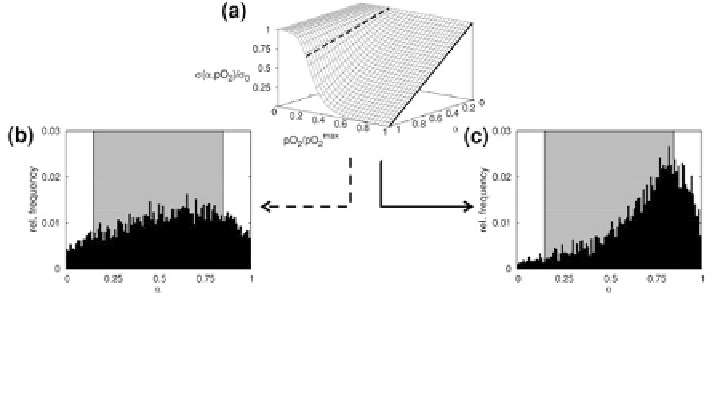Biomedical Engineering Reference
In-Depth Information
Fig. 6 Noise-landscapes of MSCs in dependence of the oxygen tension. a A low oxygen
environment (5% pO
2
) is characterised by high noise amplitudes in all states (dashed line), while
a high oxygen environment (20% pO
2
) is characterised by low amplitudes in high a-states (solid
line).
b, c The a-profiles of the low and high oxygen environments for s = 11 h
substrate, can move, grow and divide. Cell proliferation is modelled assuming a
two phase cell cycle where during the interphase, a cell doubles its volume by
stochastic increments and during the mitotic phase, a cell divides into two daughter
cells of equal properties. Thereby, cell shape is often approximated by a sphere
(see Fig.
7
a) and the elastic deformation of a cell subject to compression by other
cells or substrate is modelled by the Hertz-Model [
49
]. Contact inhibition of
growth is considered by these models assuming that a cell stops growth if the sum
of contact forces on it exceeds a critical threshold value.
Simulating monoclonal expansion by applying such an individual cell-based
model one observes a specific distribution of proliferating cells within the growing
clone [
26
,
32
], with quiescent cells located in the core and proliferating cells at the
periphery of the clone. In such simulations one can simply record the pedigree of
the clone and can calculate the spatial distribution of the different generations
throughout it. Thereby, the generation numbers are uniquely defined for all cells by
the recursion m
l
= m
m
= m
k
? 1 for the daughter cells l and m of mother cell k;
i.e. m counts for the number of divisions that has been carried out until the cell was
born. The result of such a simulation is shown in Fig.
7
c. One observes a heter-
ogeneous distribution with 'younger' cells in the core and 'older' cells at the
periphery. Within about 12 days differences in 'age' of more than ten generation
have been established.
Obviously, MSC shape is very different from being spherical-like. Considering
that the cell-cell interactions resulting in contact inhibition of growth depend on
the cell shape, the reliability of simulation results, as shown in the top row of
Fig.
7
, seems to be questionable. We therefore developed a more sophisticated
model of MSCs that explicitly accounts for podia formation [
38
]. This approach
builds on the model assuming spherical cell bodies. In addition, cells feature podia
that generate forces for cell spreading and movement. Podia of model cells retract

Search WWH ::

Custom Search